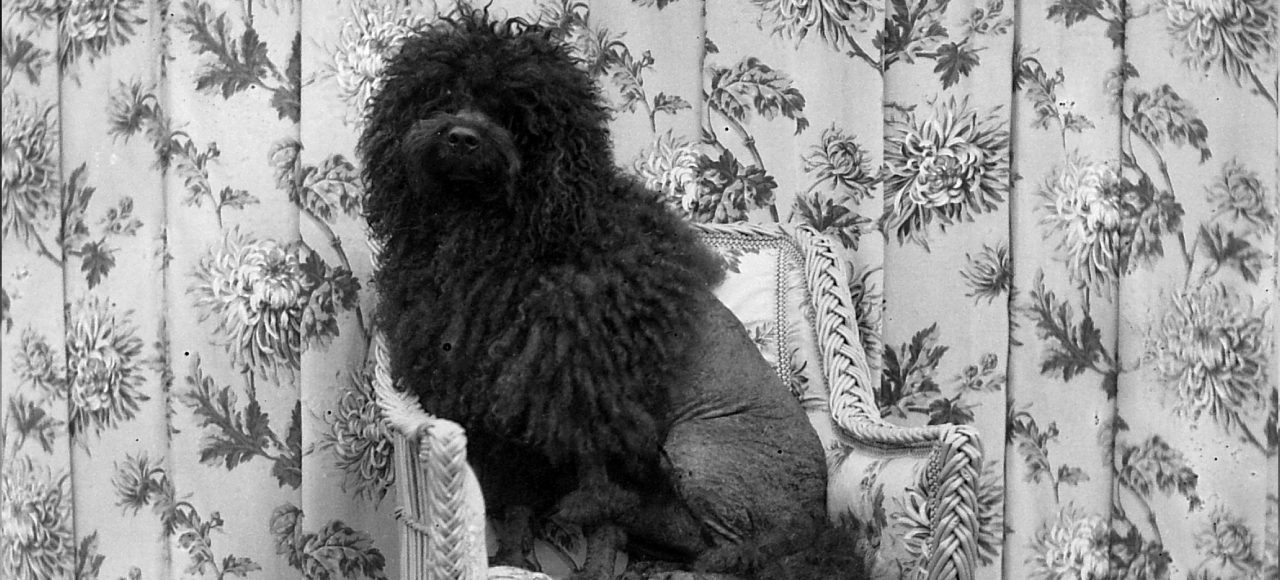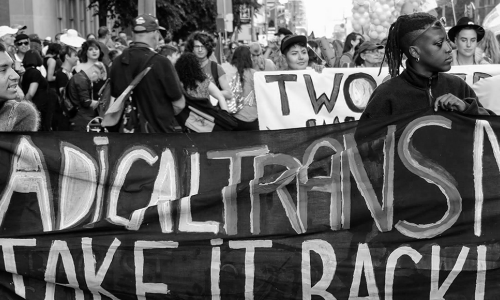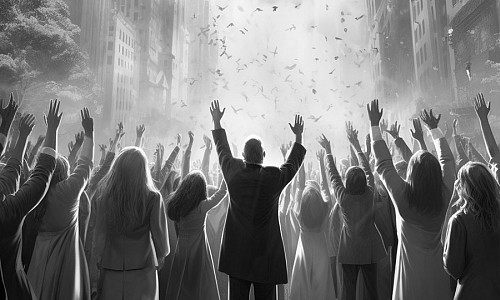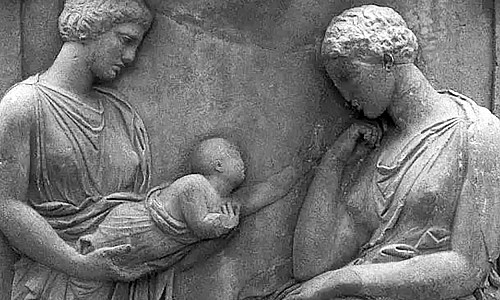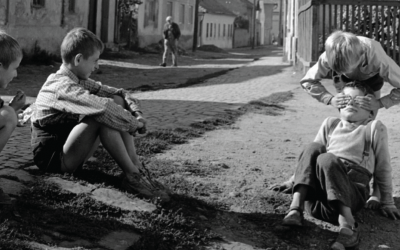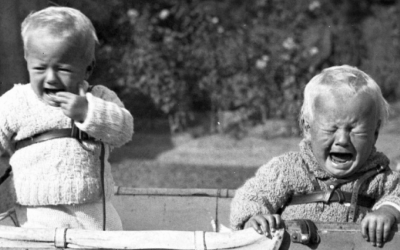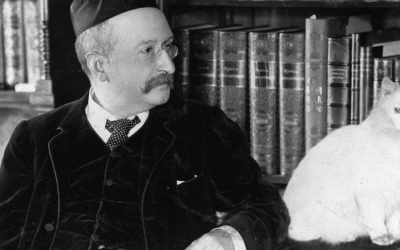Mark Rowlands asks whether animals can be moral.
It is the middle of the night, and two cold, wet noses are pressed against my face. Get up, you negligent parent, say the noses, your son needs you. Sometimes it seems that almost every day, one will see a newspaper report on a tragic incident where mixing children and dogs has gone horribly wrong. Less reported, because far less newsworthy, are cases where such mingling has gone horribly right. Given that the noses belonged to Nina, a grizzled old warrior German shepherd/malamute mix, and Tess, a wolf hybrid with some rather highly developed predatory instincts, I was somewhat concerned about how they would fare, sharing a house with my nascent son. I needn’t have worried. Crawled on, dribbled on, kicked, elbowed and kneed: these occurrences were all treated with a resigned fatalism. The daily finger-in-the-eye was shrugged off with an almost Zen-like calm. During the year or so that their old lives overlapped with his, I was alternately touched and amazed by the kindness, toleration and patience they exhibited towards my son. Kindness, toleration and patience seem to be moral phenomena. They are forms of what we might call concern – emotional states that have as their focus the wellbeing of another. But concern for the welfare of others seems to lie at the heart of morality. If Nina and Tess were acting on the basis of concern then, it seems, they were acting morally.
At this point, there is a word that typically enters the debate: anthropomorphism – the misguided attribution of human-like qualities to animals. Perhaps my describing Nina and Tess’s behaviour in moral terms was simply an anthropomorphic delusion? Of course, if I am guilty of anthropomorphism, then so too are a myriad of other companion animal owners. Such an owner might describe their dog as “friendly”, “playful”, “gentle”, “trustworthy”, or “loyal” – a “good” dog. The “bad” dog they try to avoid at the dog park, on the other hand, is bad because he is “mean”, “aggressive”, “vicious”, “unpredictable”, a “bully” and so on. Nor are these seemingly moral descriptions entirely useless. On the contrary, when an unfamiliar dog is bearing down on you in the street, being able to work out into which category it falls is a valuable skill to have. If I’m guilty of anthropomorphism, so too, it seems, are many others.
Mass delusion is always a possibility. Nevertheless, there is a large and growing body of evidence indicative of at least apparent moral behaviour in animals. As a result, a small but growing number of professionals are at least flirting with the idea that animals can act morally. In Primates and Philosophers, the primatologist, Frans de Waal, has argued that animals are at least capable of proto-moral behaviour: they possess the rudiments of morality even if they are not moral beings in precisely the way we are. This was also Darwin’s view in The Descent of Man. In a similar vein, the biologist, Marc Bekoff, has been arguing for years that animals can act morally (see Wild Justice, co-written with Jessica Pierce, for a useful overview). Let us look at some evidence.
First, my favourite – delusional dog owner that perhaps I am. A dog has been hit by a car, and lies unconscious on a busy motorway in Chile. The dog’s canine companion, at enormous risk to its own life – personally, I cringed my way through the video – weaves in and out of traffic, and eventually manages to pull the unconscious dog to the side of the road. You can check this out on YouTube – www.youtube.com/watch?v=-HJTG6RRN4E – and you’ll find plenty more cases like it there. Indeed, it seems YouTube is rapidly becoming the biggest single repository of evidence for apparently moral behaviour in animals.
Eleanor, the elephant matriarch of her family, is dying. Unable to stand, Grace, a female elephant from another family, attempts to help her, lifting and pushing her back to her feet. She tries to get Eleanor to walk, nudging her gently along. But Eleanor falls again. Grace appears very distressed, and shrieks loudly. She persists in trying to get Eleanor back to her feet, to no avail. Grace stays by the fallen figure of Eleanor for another hour, while night falls. In the morning, she returns with another elephant, Maui, and they both try to get Eleanor to stand. Eleanor dies an hour later.
Grace is not unusual among elephants. A young female elephant suffers from a withered leg, and can put little weight upon it. A young male from another herd charges the crippled female. A large female elephant chases him away and then, revealingly, returns to the young female and gently touches her withered leg with her trunk. Joyce Poole, who described this event, concludes that the adult female was showing empathy.
Binti Jua, a gorilla residing at Brookfield Zoo in Illinois, had her fifteen minutes of fame when she came to the aid of three-year old boy that had climbed onto the wall of the gorilla enclosure and fallen twenty feet onto the concrete floor below. Binti Jua lifted the unconscious boy, gently cradled him in her arms, and growled warnings at other gorillas that tried to get close. Then, while her own infant clung to her back, she carried the boy to the zoo staff waiting at an access gate.
Continuing with the simian theme: Knuckles has cerebral palsy – the only known chimpanzee with this condition, one that leaves him impaired, both physically and mentally. The other chimpanzees in his group treat him quite differently from the way in which a young male would normally be treated. For example, Knuckles rarely has to contend with the intimidating displays of aggression typically directed at younger males by their older peers. Even the alpha male tolerates Knuckles, and often grooms him gently.
The evidence of apparently moral behaviour in animals is large and growing by the day – these examples barely scratch the surface. Indeed, much of the evidence has been around for a long time but – because of various idiosyncrasies in the development of psychology during the last century – languished unrecognised. As long ago as 1959, Russell Church demonstrated that rats would not push a lever that delivered food if doing so caused other rats to receive an electric shock. A few years later, Stanley Wechkin demonstrated that hungry rhesus monkeys would not take food if doing so subjected another monkey to an electric shock. One monkey persisted in this refusal for twelve days, almost starving itself to death.
Nevertheless, dissenting voices aside, the official position of most philosophers and scientists is that animals are not capable of acting morally. The scepticism of philosophers and scientists actually takes somewhat different forms. And since this journal is called The Philosophers’ Magazine rather than The Scientists’ Magazine it comes as, perhaps, no surprise that I am going to focus on the former.
Here is a useful entry point into the typical philosopher’s scepticism. Going back to the case of the two “good” dogs with which I began this paper, what do we say about the other side of the coin – the tragic cases where a child is killed or injured by the family dog? If animals can act well – in the moral sense – then, it seems they can also act badly. If animals can be morally praiseworthy, then they can also be morally blameworthy. At one time, courts of law set up to try (and, often, subsequently execute) animals for perceived indiscretions were not uncommon. I assume no one wants to revert to these, and underlying this reluctance is the thought that, whatever else is true of animals, they are not really responsible for what they do. While it is true that a dog that kills or injures a child will be routinely destroyed, this is generally justified on grounds of safety rather than blame.
However, if animals are not responsible for what they do, this seems to imply that they cannot act morally. To see why, consider a famous principle associated with the philosopher, Immanuel Kant: ought implies can. It doesn’t make sense to suppose that I ought to do something if I am incapable of doing it. Nor does it make sense to say I shouldn’t do something if I can’t help myself. To say that you ought or ought not to do something is to imply that you have a say in the matter – you are capable of choosing what it is you are going to do, or capable of refraining from whatever it is you are tempted to do. However, moral motivations seem to imply that you have this ability. A morally good motivation is one that you ought to endorse or act on. A morally bad motivation is one that you ought to resist. So animals can’t act morally, it seems, unless they are responsible for what they do – and then, it seems, we are back to medieval animals trials.
There is also a standard philosophical account of how to explain responsibility. Responsibility is a matter of having control over one’s motivations, and control over one’s motivations is explained in terms of the ability to critically scrutinise those motivations. This idea has a prominent role in several major moral traditions, most obviously the tradition inspired by Kant. For example, Christine Korsgaard, a prominent Kantian who has explicitly applied Kant’s ideas to the question of whether animals can act morally, writes:
“Kant believed that human beings have developed a specific form of self-consciousness, namely, the ability to perceive, and therefore to think about, the grounds of our beliefs and actions as grounds. Here’s what I mean: an animal who acts from instinct is conscious of the objects of its fear or desire, and conscious of it as fearful or desirable, and so as to-be-avoided or to-be-sought. That is the ground of its action. But a rational animal is, in addition, conscious that she fears or desires the object, and that she is inclined to act in a certain way as a result. That’s what I mean by being conscious of the ground as a ground. So as rational beings we are conscious of the principles on which we are inclined to act. Because of this, we have the ability to ask ourselves whether we should act in the way we are instinctively inclined to. We can say to ourselves: ‘I am inclined to do act-A for the sake of end-E. But should I?’”
We find a cognate idea in the, otherwise very different, Aristotelian tradition. In a famous passage in the Nichomachean Ethics Aristotle writes:
“But for actions in accord with the virtues to be done transparently or justly it does not suffice that they themselves have the right qualities. Rather, the agent must also be in the right state when he does them. First he must know that he is doing virtuous actions; second, he must decide on them, and decide on them for themselves; and, third, he must also do them from a firm and unchanging state.”
For an action to be virtuous, it must not simply be an example of what would commonly be regarded as a virtuous action (have the “right qualities”). In addition, the agent must (a) know that he is performing a virtuous action, and (b) perform the action because it is a virtuous action (“decide on them for themselves”). In other words, to act virtuously, you need to understand what a virtue is and act in the way that you do because you want to be virtuous.
The general idea, therefore, is that to act morally, we need to be able to scrutinise our motivations, understand whether or not they are morally good or bad, and act on them – or refuse to act on them – on this basis. If animals lack these abilities, they cannot act morally, and it seems likely they lack these abilities. Did the apparently heroic dog think to itself: “I am inclined to drag my companion to safety. Is this an inclination I should act on or one that I should resist?” Or, if we imagined the dog as an Aristotelian: “Would this be a virtuous thing to do?” According to (many) philosophers, it is not simply that the dog did not engage in this sort of scrutiny of its motivation that is important. What is crucial is that it cannot do this – it lacks the ability to scrutinise its motivations. Often, we act unreflectively too – dashing into burning buildings to save babies, and things like that, without a thought to the consequences. But the difference, philosophers say, is that we can scrutinise our motivations even if, in particular cases, we do not. Therefore, philosophical orthodoxy has it: (i) lacking the ability to critically scrutinise its motivations, the dog has (ii) no control over those motivations, and so (iii) cannot be held responsible for them. But, (iv) ought implies can: without responsibility there can be no moral behaviour. Therefore, (v) animals cannot act morally.
Nevertheless, despite its widespread acceptance, I think this orthodoxy can be challenged in at least two ways. The first challenge focuses on the idea of critical scrutiny of motivations and, in particular the idea that we can explain control over motivations in terms of our ability to critically scrutinise them. There is a type of problem that afflicts certain sorts of attempted explanations. It is called a regress, and it happens when an explanation doesn’t do the job it is supposed to do but merely defers the question – pushes the issue back a step. This sort of problem arguably afflicts the idea that we can explain control in terms critical scrutiny. Suppose I am inclined to help a dog I see lying unconscious in the middle of a busy road. Do I have control over this inclination? According to the standard philosophical view, I have control over it as long as I am capable of critically scrutinising it – of asking myself whether I should act on this inclination or resist it.
But suppose I have no control over the answer I give to this question? Much recent work in psychology – of a broadly situationist sort – suggests that the answer I give to these sorts of questions can be skewed by environmental influences of which I am unaware, and so over which I have no control. Whether or not this work is correct, the more important point is that the ability to engage in critical scrutiny of my motivations will give me control over them only if I have control over the critical scrutiny. We began with the problem of explaining my control over my motivations, but have merely substituted for this another problem: the problem of explaining my control over my critical scrutiny. This has all the hallmarks of a classic regress problem. We haven’t explained control at all, merely pushed the problem back a step.
The second way of challenging the philosophical orthodoxy is by pointing out that there is another way of understanding the “ought” of moral motivation – a way that has nothing to do with control. There is, for example, the “ought” of prudence. If you want to live for a long time, then you ought – prudentially – to give up smoking, drinking to excess, and the helmetless riding of your Harley Davidson at ridiculous speeds. This “ought” has nothing to do with control. Even if you are completely incapable of resisting the urge to smoke, drink, and motorcycle helmetlessly, it is still true that you ought to do so, prudentially speaking, if you want to live a long and healthy life. You ought to give up these things in the sense that this is the prudent thing to do – and this is true even if you can’t bring yourself to give them up.
There is a corresponding way of understanding the “ought” of moral motivation that has nothing to do with having control over those motivations. In this sense, you ought to do something because it is a good thing to do – and this is true even if you are incapable of doing it, or refraining from doing it. One might say that the dog ought to help his friend lying prone on the road, because it is a good thing to do – even if the dog has no control over whether or not he does this. This is sometimes called an externalist sense of the moral ought.
So, I think the traditional way of understanding the “ought” of moral motivation in terms of the idea control is questionable, and there is another way of understanding this “ought” that does not rest on this control. This opens up the possibility of a new way of thinking about the moral capacities of animals. Animals can, in fact, act morally even if they are not responsible for what they do. Animals can be motivated by the desire to do good (and also bad) things even if they are not responsible for their actions. The dog can be motivated by the desire to rescue his companion, and rescuing his companion is a good thing. But this does not imply that the dog is responsible for what it does. This allows us to make sense of the growing body of evidence that supports the idea that animals can act morally without returning us to the merry old heyday of animal trials. It is, I think, exactly the right way to think about animals and their moral abilities.
Mark Rowlands is Professor of Philosophy at the University of Miami. He is author of sixteen books, including The Philosopher and the Wolf and Can Animals Be Moral? He blogs at rowlands.philospot.com.
You might also like...
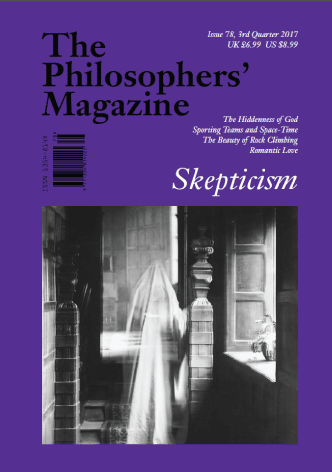
Subscribe to The Philosophers' Magazine for exclusive content and access to 20 years of back issues.

